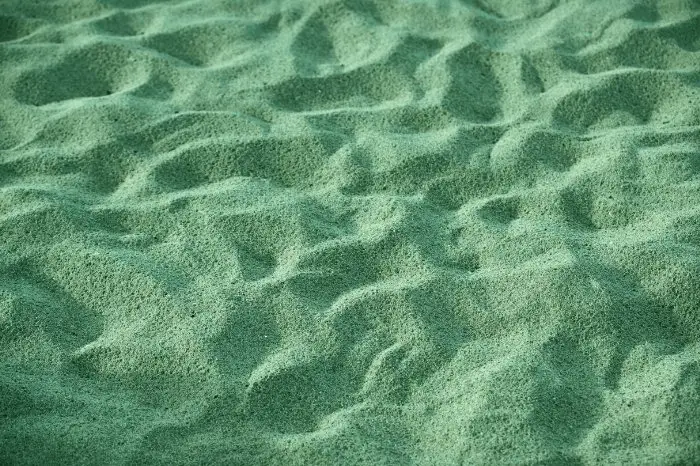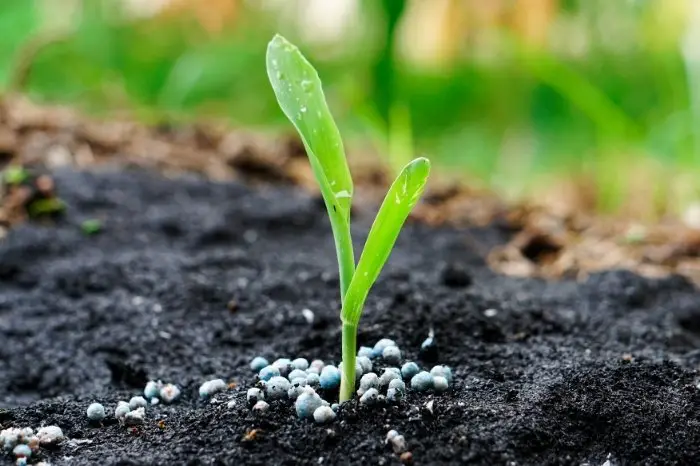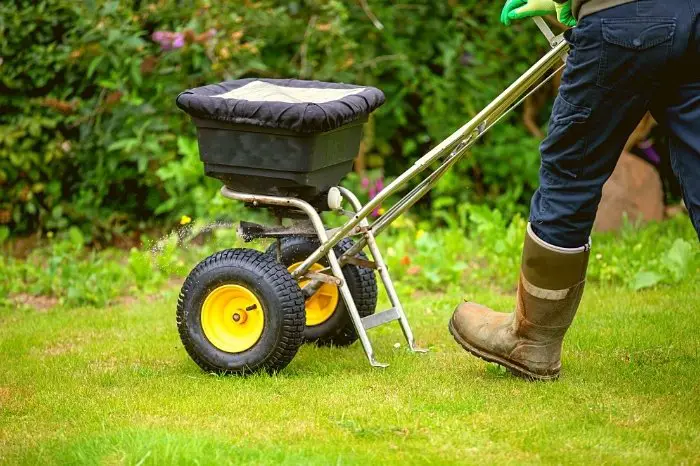Last Updated on October 26, 2022
Green sand soil amendment goes a long way in improving your soil in whatever USDA zone you are gardening from.
Soil improvements are necessary for organically improving your soil by providing the required nutrients. The green sand soil supplement is necessary for improving the mineral content of your soil.
This organic soil supplement is widely available at many organic and nursery centers and contains a high quantity of minerals giving the gritty mix of a greenish color its name.
What Is The Green Sand Soil Amendment?
Green sand is the bottom sediment deposit layer harvested from ancient ocean floors. Recently it has gone through a weathering process turning it into a fine sand texture. The greenish color the sand has comes from minerals such as iron ore and glauconite. These minerals come from rocks and are made up of particles of clay, mica, and other minerals.
One of them is the most common green sand sold in the United States is called Jersey green sand. It comes from the state of New Jersey, in geological history, New Jersey was once underwater. When the water receded, it left marine sediment deposits data now mind and ride as green sand.
New deposits have also been found in Kansas and East Texas. Many countries along the Mediterranean sea have deposits of the material as well as England.

What Is Green Sand In Casting?
This is the process that the green sand goes through from harvesting to packaging preparing it and getting it ready for gardeners to use in their farms.
What Does Green Sand Do For Your Soil?
Green sand provides a slow and gentle release of minerals protecting your plants from the classic root burn that fertilizers cause. Using this supplement as a soil conditioner provides a good source of potassium in a 0-0-3 ratio.
It contains up to 30 different minerals which enrich the soil and are easy for plants to uptake. One of the biggest benefits of using green sand in your soil is the ability to break up hard soils like clay, allow oxygen into the soil and increase drainage. The exact amount of green sand to add to your soil will vary depending on what the manufacturer produces the compound. Some manufacturers add sand to the mixture to impact the strength of the product. The condition of your soil also dictates how much green sand fertilizers you need to use for maximum effectiveness.
Why Is Green Sand Helpful?
Green sand is a soil amendment that helps better the condition of your soil it works to loosen the soil and improve heavily compacted clay soil. Waste material goes down into the soil pushing heavy particles apart. It makes the soil lighter and provides room for roots to expand allowing air to circulate in the soil.
Green sand is also an excellent conditioner for sandy soils. Sandy soil does not absorb water rubber it allows it to pass through living it dry. Sandy soil is good for drainage but it also means nutrients leach out. When added green sand absorbs up to 10 times the amount of water that regular sand absorbs. It is also an excellent soil for most plants as it does not allow waterlogging.
Green sand also has important nutrients containing about 3% potassium and that mineral including magnesium calcium iron and phosphorus.
Another benefit of adding green sand to your soil is mineralization. Your plants require minerals to help them respirate, expel waste, and take in nutrients. These tasks require small amounts of minerals to be present in the soil. Without these minerals, your plants will not be as healthy as they should be. Green sand helps improve the overall health of your soil.
Read more about Is Horse Manure Good For Vegetable Gardens?
How Much Green Sand Do I Add To My Soil?
As a general rule mix 2 cups of green sand into the soil around each plant. For broadcast applications, use a ratio of 50 to 100 pounds per 1,000 feet of soil.
Green sand is organically certified and the green color from the glauconite helps absorb the sun and warm the soil in the early spring.
The gritty texture that the soil gas is able to soak up more moisture than the normal garden soil and conserve it for the plants’ roots.
The best supplement is easy to use and gentle even for the most sensitive plants. Apply it in early spring either as a soil amendment or a good all-purpose fertilizer.
Down to Earth Organic Greensand Fertilizer, 5 lb
Can You Use Too Much Green Sand?
If you are not sure how much green sand to add apply larger amounts of this supplement as a safe bet. Green sand does not burn your plants or over-fertilize them.
Applying too much green sand will not give your plants an extra boost as it releases the nutrients slowly by slowly.
Click here to Learn about:
Where To Use Green Sand
Green sand is not only used in your flower bed rather you can use it on your loan in farm pastures among your berry plantings or in your orchard.
The ph level of green sand varies depending on where it was harvested and other influences in the soil. It varies from slightly alkaline to slightly acidic but it doesn’t dramatically alter your sales overall. This is because it is a slow-acting supplement.
You can use green sand in the following ways:
Starting Seed
Mix green sand into your seedling mix to make it lighter. It is also good for plants that develop a taproot early and root crops like beets that are not transplanted. Mix 1 cup of green sand per gallon of seedling or starter mix.

House Plants
Every time you have plants in your container you need to give them attention to the roots and ensure they have the right conditions they need to grow. Greens and helps the condition of the soil improve so that the roots can easily spread out. Add 4 tablespoons of green sand per gallon of potting soil and mix well this will help improve your house plants providing them with minerals that help make chlorophyll.
Fruit Trees
Sprinkle 2 cups of greens and into the soil around your fruit trees and spread it along the drip line to make it accessible to the roots. If you own a large orchard spread 50 lb of greens and 1000 square feet.
Vegetable Gardens
Application rates depend on the soil conditions full stop for example if you have a good foundation based on a soil test you will only need to supplement as a soil conditioner. Apply 25 lb per 1,000 square feet. If you have mineral deficiencies in phosphorus calcium magnesium or iron add green sand to help your soil long-term
Yard
Greens and helps improve your lawn loosening up compacted soil and adding nutrients. You can sprinkle it along with lawn seed in a new area or sprinkle directly onto your yard at a rate of 16 lb per 1000 square feet.

Compost Pile
Sprinkle a cup of green sand into your compost pile every time you add a green layer for use in the layering method. This supplement increases the nutrients in your pile and benefits your microbes.
Any areas that show minerals deficiency. Apply green sand in any part of your garden that shows minerals deficiency. If you notice your plants suffering from chlorosis or lack of adequate chlorophyll save them by applying green sand. Green sand adds minerals to the soil and helps alleviate this deficiency.
FAQs
What does greensand do to soil?
Greensand is the sand, silt and clay that is mixed in with the topsoil of the ground. It is a key ingredient for building healthy soil, and a great addition to your garden soil. The three main components of greensand are quartz (silica), iron oxide (ferric oxide) and manganese oxide (manganous oxide).
How do I use greensand?
The first thing you need to do is mix the greensand into your garden soil. Greensand should be added at a rate of one part greensand to four parts soil. You may add more or less depending on how much you want to apply. Greensand should be mixed into your soil before you plant seeds or seedlings.
Greensand can be added to soil as part of an aggregate material (sand or gravel), or in dry form. The primary effect is that the soil becomes more stable and less prone to erosion.
Is greensand toxic?
It might be toxic to some crops.
Greensand is a naturally occurring silicate mineral that comes from the soil and has been used as a fertilizer since ancient times. It can be found in most soils and is often added to them.
Greensand is composed of silicon, oxygen, magnesium, aluminum, iron, and potassium. It’s used by farmers to grow crops.
How does greensand work?
The silicon in greensand helps plants grow. Plants use silicon to build cell walls and create new cells. Magnesium helps plants absorb nutrients. Aluminum helps make plants more resistant to disease. Iron helps plants use water and produce energy. Potassium helps plants produce proteins, carbohydrates, and fats.
Can you use too much greensand?
Green sand is very useful in growing plants.
It contains all the necessary minerals and nutrients needed by the plant to grow. You can add as much as you want. However, if you don't know the exact composition of the green sand you are using, you should add enough to give your plants the required amount of nutrients and minerals.
What plants benefit from green sand?
Green Sand is a natural fertilizer that can be used to grow a variety of plants. The sand has the nutrients that are necessary to provide food and moisture for the plants. The sand also has a high pH level, so it is very easy on the plants and will not burn them or harm them in any way. If you have ever had a problem with your soil being too acidic, then using green sand could help.
Green sand is an organic material that absorbs nutrients, toxins and minerals from the water as it travels through the sand.
It is also a form of mulch that helps to prevent soil erosion.
Conclusion
If you make green sand soil amendment a part of your garden you will only have good things to say about it. It is a useful soil conditioner that addresses a wide range of problems you face in your gardening journey.
Add it to loosen heavy clay soils or bind sandy soils together. You will have no regrets!

Lory is an avid gardener who loves spending time outdoors. She is passionate about using her green thumb to create beautiful, lush gardens for her friends and family. She finds joy in tending to her garden, trimming plants, and cultivating new species. She loves to share her knowledge and experience with others who have a similar enthusiasm for gardening. Lory is a true nature enthusiast who loves to share her enthusiasm for the outdoors with all who meet her.

